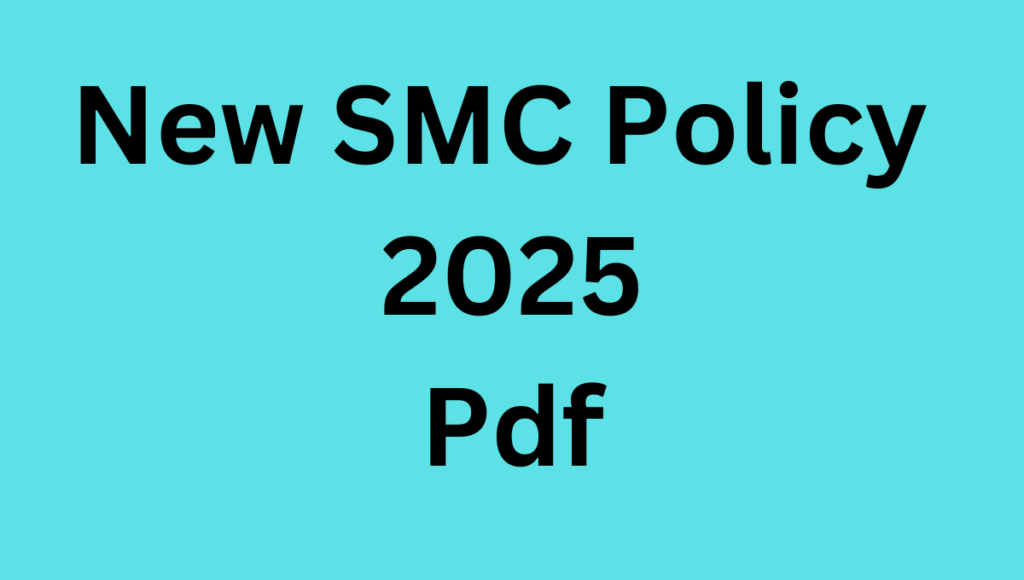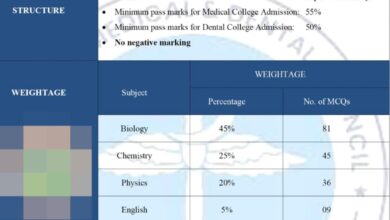New SMC Policy 2025
Contents
- 1 Empowering Education: The Punjab School Management Councils Policy 2024
- 2 Introduction to the Punjab SMC Policy 2024
- 3 Core Principles of the Policy
- 4 Structure and Composition of School Management Councils
- 5 Key Functions of SMCs
- 6 Financial Procedures and Transparency
- 7 Capacity Building and Community Engagement
- 8 Challenges and Mitigation Strategies
- 9 FAQs
- 10 Conclusion
Empowering Education: The Punjab School Management Councils Policy 2024
The Punjab School Management Councils Policy, 2024, introduced by the Government of Punjab’s School Education Department, marks a transformative step toward enhancing community engagement in public schools. Notified on January 20, 2025, this policy aims to foster collaboration, transparency, and accountability to improve the quality of education across Punjab’s public school system. By empowering School Management Councils (SMCs), the policy seeks to create a dynamic and inclusive educational environment that ensures every child has access to quality learning opportunities. This article explores the key aspects of the policy, its objectives, structure, and anticipated impact, drawing on official details and broader educational trends.
Introduction to the Punjab SMC Policy 2024
Approved by the Provincial Cabinet on December 19, 2024, the Punjab SMC Policy 2024 establishes a framework for strengthened community engagement in public schools. It leverages the powers under Rule 3(3) and the Second Schedule of the Punjab Government Rules of Business, 2011, to promote a collaborative ecosystem involving school staff, parents, community members, and youth representatives. The policy applies to all public sector schools under the School Education Department, including those managed through public-private partnerships. Its core objective is to enhance educational outcomes by fostering transparency, resource mobilization, and community-driven school improvements.
- Key Objective: Create an empowered community engagement structure to improve school operations, infrastructure, and educational quality.
- Scope: Covers all public schools in Punjab, ensuring inclusivity across urban and rural areas.
- Vision: To build a dynamic, accountable public school system that empowers students as critical thinkers and responsible citizens.
For more details on Punjab’s educational reforms, visit the Government of Punjab’s official website.
Core Principles of the Policy
The policy is guided by three foundational principles that shape its implementation:
- Collaboration and Participation: Encourages active involvement of school staff, parents, and community members to create a synergistic educational environment.
- Sustainability and Development: Prioritizes efficient resource use, community support, and infrastructure development for a conducive learning environment.
- Transparency and Accountability: Promotes open communication and mutual responsibility among stakeholders to ensure equitable access to education.
These principles align with global trends in education governance, as highlighted by UNESCO’s education initiatives, which emphasize community involvement for sustainable education systems.
Structure and Composition of School Management Councils
The SMC Policy mandates the formation of School Management Councils in each public school during the first month of the summer vacation, with a three-year term. Each SMC comprises at least ten members, ensuring diverse representation:
| Category | Number | Description |
|---|---|---|
| Parent Members | 3 | Parents or guardians of enrolled students, gender-specific to the school type. |
| Teacher Members | 2 | School head and senior-most teacher as ex-officio members. |
| General Members | 3 | Notable community individuals (e.g., philanthropists, alumni, retired officials). |
| Special Member | 1 | Parent or guardian of students from religious minorities or with special needs. |
| Youth Member | 1 | Male or female (based on school type), aged 25–35, preferably with a bachelor’s degree. |
| Co-opted Member | Variable | Non-voting member co-opted by SMC consensus for specific expertise. |
- Leadership Roles:
- Chairperson: The school head, serving ex-officio.
- Vice-Chairperson: Elected from parent, general, or youth members by majority vote.
- Secretary: The senior-most teacher.
The selection process, detailed in the policy, involves a structured committee led by education officers (e.g., AEO, DDEO, or DEO-SE) and includes community representatives like the Chairperson of the Union Council and a senior citizen. For further insights into community-based education models, refer to World Bank’s education resources.
Key Functions of SMCs
SMCs are entrusted with a wide range of responsibilities to enhance school operations and educational quality:
- School Operations:
- Promote regular attendance and punctuality for teachers and students.
- Ensure inclusivity for children with special needs and minority communities.
- Collaborate with health authorities for student health screenings (e.g., hearing aids, glasses).
- Prohibit corporal punishment and harassment.
- Maintain infrastructure, furniture, and playgrounds.
- Quality Education:
- Refer underperforming teachers to the District Education Authority (DEA) for disciplinary action.
- Recommend awards for high-performing teachers.
- Enrollment of Out-of-School Children (OOSC):
- Identify OOSC and collect their details for enrollment.
- Conduct community awareness campaigns on education’s importance.
- Provide scholarships or financial aid for economically disadvantaged students.
- Financial Management:
- Prepare annual budgets using government allocations, community contributions, and fundraising.
- Ensure transparent fund utilization, with exemptions from standard government financial rules for expenditures up to PKR 2.5 million.
- Infrastructure Development:
- Oversee construction and maintenance of classrooms, toilets, and boundary walls.
- Work with DEA’s engineering staff for technical supervision and quality assurance.
- School Improvement Plan:
- Develop a three-year plan with annual sub-plans to address infrastructure, teacher shortages, and future needs.
For a deeper understanding of school improvement strategies, explore OECD’s education policy outlook.
Financial Procedures and Transparency
The policy outlines robust financial procedures to ensure transparency and accountability:
- Funding Sources:
- Non-Salary Budget (NSB) and Bonus Grants based on SMC performance.
- Donations from alumni, philanthropists, CSR funds, and NGOs.
- Farogh-e-Taleem Fund.
- Utilization:
- Funds can be used for infrastructure, teaching materials, sports equipment, and community teacher salaries.
- Expenditures up to PKR 2.5 million are exempt from government financial rules and audits by the Auditor General of Pakistan.
- Audit Mechanism:
- Internal Audit Committee (IAC): Comprises SMC members, conducts quarterly and annual audits.
- District Audit Committee: Audits 30–40% of SMCs annually, submits reports to the School Education Department.
- Departmental Audit Committee: An independent firm audits 5–10% of SMCs for compliance.
These measures align with global best practices for financial transparency in education, as discussed in Transparency International’s education governance reports.
Capacity Building and Community Engagement
The policy emphasizes capacity building for SMC members through comprehensive training programs focusing on:
- Financial management and digital literacy.
- Inclusivity, diversity, and disaster risk reduction.
- Community engagement and social mobilization.
- Development and implementation of School Improvement Plans.
These programs aim to equip members with the skills needed to execute their roles effectively, fostering a culture of collaboration and innovation. For global perspectives on capacity building, see UNICEF’s education programs.
Challenges and Mitigation Strategies
While the policy is ambitious, potential challenges include:
- Community Participation: Ensuring consistent engagement from diverse community members.
- Resource Constraints: Limited funding for infrastructure and teacher hiring.
- Capacity Gaps: Varying levels of expertise among SMC members.
The policy addresses these through structured selection criteria, training programs, and a dispute resolution mechanism led by education officers. The Department also retains the power to amend the policy to address emergent needs.
FAQs
Q1: Who can become a member of an SMC?
A1: SMC members include parents, teachers, community notables, youth representatives, and special members (from minorities or special needs groups). Eligibility criteria emphasize passion for education, community influence, and leadership skills.
Q2: How are SMC members selected?
A2: A selection committee, led by education officers (AEO, DDEO, or DEO-SE), reviews applications, conducts interviews, and selects members based on merit and suitability within a 22-day timeline.
Q3: What is the role of the School Education Department in SMC operations?
A3: The Department provides training, establishes funding frameworks, develops infrastructure guidelines, and conducts monitoring, evaluation, and audits.
Q4: How does the policy address out-of-school children?
A4: SMCs identify OOSC, conduct awareness campaigns, and provide financial assistance to facilitate their enrollment.
Q5: What happens if an SMC member resigns or is removed?
A5: Vacancies are filled through the same selection process if more than six months remain in the SMC’s term, ensuring continuity.
Conclusion
The Punjab School Management Councils Policy 2024 is a visionary initiative to transform public education in Punjab by empowering communities and fostering accountability. By integrating parents, teachers, and local stakeholders into school governance, the policy aims to enhance educational quality, increase enrollment, and improve infrastructure. Its emphasis on transparency, inclusivity, and capacity building positions it as a model for educational reform. As Punjab implements this policy, its success will depend on effective training, robust community engagement, and adaptive governance. This policy not only strengthens schools but also lays the foundation for a brighter, more equitable future for Punjab’s students.



